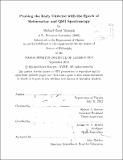| dc.contributor.advisor | Robert A. Simcoe and Jacqueline N. Hewitt. | en_US |
| dc.contributor.author | Matejek, Michael Scott | en_US |
| dc.contributor.other | Massachusetts Institute of Technology. Department of Physics. | en_US |
| dc.date.accessioned | 2013-07-10T14:51:29Z | |
| dc.date.available | 2013-07-10T14:51:29Z | |
| dc.date.copyright | 2012 | en_US |
| dc.date.issued | 2012 | en_US |
| dc.identifier.uri | http://hdl.handle.net/1721.1/79521 | |
| dc.description | Thesis (Ph. D.)--Massachusetts Institute of Technology, Dept. of Physics, 2012. | en_US |
| dc.description | Cataloged from PDF version of thesis. | en_US |
| dc.description | Includes bibliographical references (p. 185-198). | en_US |
| dc.description.abstract | We present results from the first systematic survey for Mg ii absorption lines at z > 2.5. Using 46 infrared QSO spectra we discovered 111 Mg II systems, including five with z > 5- the most distant systems now known. The comoving line density for weaker systems is statistically consistent with no evolution from z = 0.4 to z = 5.5. The density for stronger systems increases three-fold until z ~ 3 before declining towards higher redshifts, suggesting a connection to star formation. The weaker systems' lack of evolution does not fit within this interpretation, but may be reproduced by extrapolating low redshift scaling relations between host galaxy luminosity and absorbing halo radius to earlier epochs. Using new measurements from optical spectra of the same targets and low redshift control samples we study evolutionary trends in the chemical composition of Mg ii systems from z = 0 --> 5.33. We observe a significant strengthening in the characteristic N(H I) for fixed Mg 11 strength as one moves toward higher redshift. We set lower limits on the metallicity where we can measure H 1, and find that systems with W₀ [delta]2796 = 0.3 - i.OA are quite metal rich at ~ 0.1 Solar. We speculate that if weaker Mg ii systems represent accreting gas, then their high metal abundance suggests re-accretion of recently ejected material rather than first-time infall from the metal-poor IGM, even at early times. We present a new technique for simultaneously fitting bright point sources in ungridded visibility data called the side lobe matrix technique. We provide computational speedups which allow for real time implementation. We derive analytic approximations for the error distributions of fit intensities in the presence of thermal noise, imperfect calibration, and ionospheric errors. We find that the intensity errors of the brightest sources with imperfect calibration and ionospheric errors are dominated by 'self errors' that exist independent of side-lobe contamination. We demonstrate that to lowest order, the dynamic range obtained with calibration/ionospheric errors is the same as when the source intensities are perfectly known. | en_US |
| dc.description.statementofresponsibility | by Michael Scott Matejek. | en_US |
| dc.format.extent | 198 p. | en_US |
| dc.language.iso | eng | en_US |
| dc.publisher | Massachusetts Institute of Technology | en_US |
| dc.rights | M.I.T. theses are protected by
copyright. They may be viewed from this source for any purpose, but
reproduction or distribution in any format is prohibited without written
permission. See provided URL for inquiries about permission. | en_US |
| dc.rights.uri | http://dspace.mit.edu/handle/1721.1/7582 | en_US |
| dc.subject | Physics. | en_US |
| dc.title | Probing the early universe with the epoch of reionization and QSO spectroscopy | en_US |
| dc.type | Thesis | en_US |
| dc.description.degree | Ph.D. | en_US |
| dc.contributor.department | Massachusetts Institute of Technology. Department of Physics | |
| dc.identifier.oclc | 849759793 | en_US |
